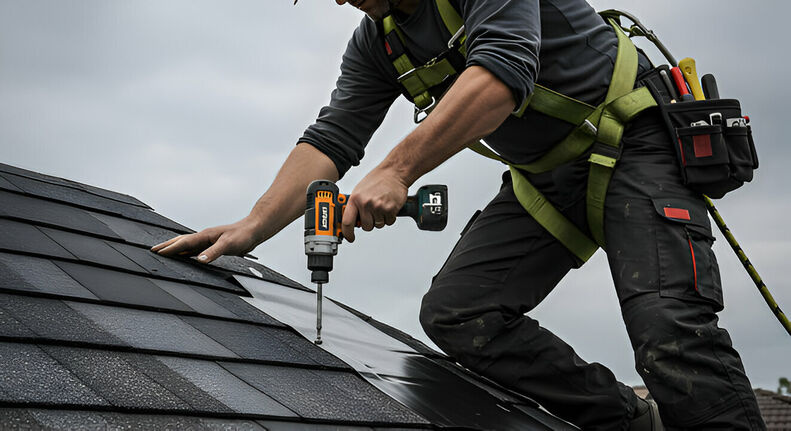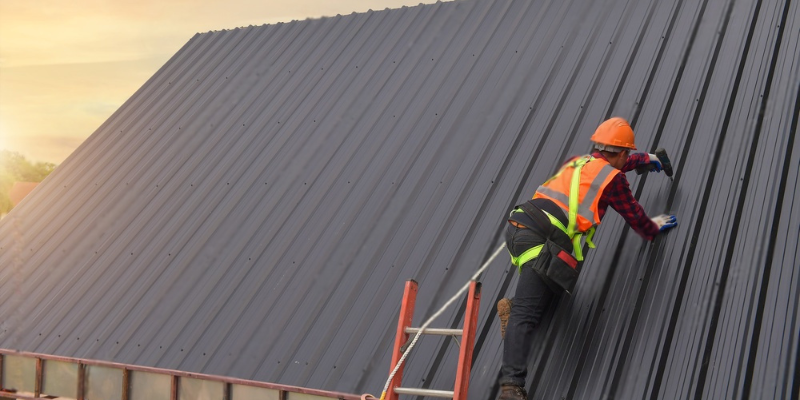The roof of a commercial building is more than just protection, it’s a major investment that keeps your property, employees, and assets safe. Regular commercial roof inspection is essential to ensure your roofing system remains in excellent condition, avoids leaks, and extends its lifespan.
If you own or manage a commercial property in 2026, this guide will help you understand everything about roof inspections, from what they include to how often they should be done.
Why Commercial Roof Inspection Is Important
Your roof faces constant exposure to the elements sun, wind, rain, and snow. Over time, even the most durable roofing materials can develop issues like cracks, pooling water, or damaged membranes.
A commercial roof inspection helps identify problems early before they turn into expensive repairs or replacements. Regular inspections:
- Detect leaks before they cause structural damage.
- Extend the lifespan of your roofing system.
- Help maintain your roof warranty.
- Ensure compliance with safety and insurance standards.
- Protect your business operations from unexpected downtime.
In short, preventive inspections save money, time, and stress in the long run.
How Often Should a Commercial Roof Be Inspected?
Industry experts recommend scheduling at least two inspections per year, once in spring and once in fall. Additional inspections are advised after severe weather events like storms or heavy snowfall.
Here’s a quick breakdown for clarity:
| Inspection Type | Recommended Frequency | Purpose |
|---|---|---|
| Routine Inspection | Twice a year (spring/fall) | Identify seasonal wear, debris, and drainage issues. |
| Post-Storm Inspection | After major storms or hail | Detect storm-related damage or leaks. |
| Warranty Inspection | As required by manufacturer | Maintain eligibility for warranty coverage. |
| Pre-Sale Inspection | Before property sale | Evaluate roof condition for real estate transactions. |
What Happens During a Commercial Roof Inspection
A professional roof inspection is a detailed process that assesses every layer of your roofing system. In 2026, many contractors use drones and infrared scanning for advanced accuracy.
Here’s what you can expect:
1. Visual Assessment
Inspectors examine the roof’s surface for cracks, blistering, punctures, or signs of water pooling. They also check flashing, drains, vents, and seams for potential weak points.
2. Structural Review
This step evaluates the integrity of the roof deck, support systems, and any visible sagging or uneven surfaces that could indicate internal damage.
3. Moisture Detection
Modern inspections use infrared or moisture meters to detect hidden water beneath the roof membrane. This helps prevent mold growth and internal rot.
4. Drainage and Gutter Check
Clogged drains are a common cause of roof leaks. Inspectors ensure that gutters and downspouts are clear and working efficiently.
5. Roof Perimeter and Penetrations
Edges, skylights, HVAC units, and vents are inspected closely since they’re common leak zones.
6. Documentation and Report
After inspection, you’ll receive a detailed report that includes photos, repair recommendations, and maintenance tips for future upkeep.
Common Issues Found During Roof Inspections
Even a small issue can become a costly problem if ignored. Here are the most common problems uncovered during commercial roof inspection:
| Problem | Description | Potential Impact |
|---|---|---|
| Ponding Water | Water accumulation after rain | Causes leaks and membrane damage |
| Cracked Membranes | Aging or UV exposure | Reduces waterproofing ability |
| Damaged Flashing | Loose or missing flashing | Leads to edge leaks |
| Clogged Drains | Debris buildup | Increases risk of water pooling |
| Poor Repairs | Low-quality past fixes | May fail under weather stress |
| Roof Blisters | Air trapped under layers | Weakens roof structure |
Identifying these early helps avoid major structural damage and unnecessary costs.
Benefits of Regular Commercial Roof Inspections
Regular inspections offer measurable advantages that go beyond surface maintenance:
- Early Problem Detection: Prevents minor issues from becoming major repairs.
- Extended Roof Life: Keeps your roof strong for decades with proper care.
- Energy Efficiency: Seals leaks and insulation gaps to reduce energy waste.
- Cost Savings: Avoids unexpected repair expenses or full replacements.
- Improved Safety: Protects employees, customers, and business operations.
Signs Your Roof Needs Immediate Inspection
You shouldn’t wait for scheduled inspections if your roof shows visible warning signs. Contact a professional immediately if you notice:
- Water stains on ceilings or walls.
- Unusual odors or mold inside the building.
- Bubbling or blistering on the roof surface.
- Higher energy bills without explanation.
- Sagging areas or visible damage after a storm.
Commercial Roof Inspection in 2026: What’s New?
Roof inspections are becoming more advanced with technology. In 2026, many contractors now use:
- Drone Roof Mapping: Provides aerial imaging for large commercial spaces.
- Infrared Moisture Scanning: Detects hidden leaks under the surface.
- Digital Reports: Instant reports with photo documentation for easy tracking.
- AI-Based Analysis: Predicts maintenance needs and repair timelines based on inspection data.
These innovations make roof inspections faster, more accurate, and more cost-effective than ever.
What Happens During a Roof Inspection?
A roofing expert will check for damage. They look at shingles, flashing, gutters, and the roof structure. They also check for leaks, weak spots, and mold. If they find a problem, they suggest repairs to prevent bigger issues.


Choosing the Right Commercial Roof Inspector
Not all contractors have the same expertise. When hiring a professional for commercial roof inspection, look for:
- Proven experience with commercial roofing systems.
- Licensing, insurance, and certifications.
- Use of modern inspection tools and technology.
- Transparent pricing and detailed reports.
- Positive client reviews and local reputation.
A reliable roofing partner ensures that your property is always protected, no matter the season.
When to Replace a Roof
If your roof is over 20 years old, consider a replacement. Signs you need a new roof include frequent leaks, major sagging, and missing shingles. A new roof improves safety and boosts home value.
Final Thoughts
A commercial roof inspection is not just a yearly task, it’s a vital part of maintaining your property’s safety, longevity, and value. Regular inspections save you money, reduce risks, and ensure your roof stays strong throughout every season.
In 2026, make roof maintenance a priority. Partner with a trusted roofing professional who understands commercial systems and uses modern inspection technology for accurate results.
Have Questions? Call Us Now!
We’re here to help—quick answers, friendly service, anytime you need!
